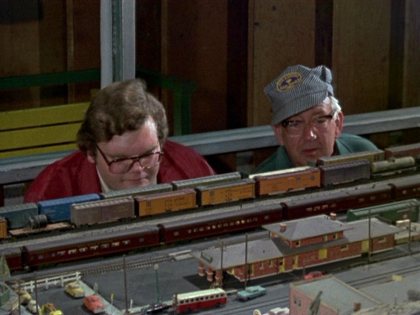Primary navigation


Nick Pinkerton on French director Jean-Pierre Gorin, whose essay films offer us the chance to see the ordinary and the day-to-day with a fresh eye
Three Popular Films by Jean-Pierre Gorin
Poto and Cabengo / Routine Pleasures / My Crasy Life
US 1980/86/92; Criterion Collection Eclipse / Region 1 DVD; 73/79/98 minutes; Aspect Ratio 1.33:1
In his 1986 film Routine Pleasures, director Jean-Pierre Gorin observes the Tuesday-night ritual of a group of rail enthusiasts who convene weekly in an unassuming building on the Del Mar Fairgrounds outside San Diego, California. Here, the members of the Pacific Beach & Western railway club – exclusively male, presumably blue-collar, mostly in middle-age or past – meet to maintain and run model trains, according to their ‘Big Board’ schedule, through a detailed town-and-field landscape first laid out in 1958.
The other side of Routine Pleasures concerns the tabletop still-lifes of Manny Farber, the American painter and film critic who had retired from publishing with a 1977 review of Chantal Akerman’s Jeanne Dielman, devoting himself to teaching at the University of California in San Diego – and to working and reworking the elements of his oil-on-board topographies with the same niggling attention he once devoted to the placement of adjectives.
Gorin (who moved to the US from his native France in 1975) locates his adopted America at the intersection of these two private, obsessively recreated worlds, that of the PB&W (whose painstaking scenery expert recalls taking a “history course on geology, how the land formations were actually formed…”) and that of Farber’s deeply personal canvases, such as Birthplace: Douglas, Ariz. (Farber said, in a 1977 interview: “The landscape that I live in is very important, just as the language that I decided on as a critic was excruciatingly important.”)
It was Farber who, when organising the film programme at the still-young university’s Department of Visual Arts, brought Gorin from Paris to UCSD to lecture on film aesthetics. Gorin is there still; a look at his student-generated gradings on RateMyProfessors.com turns up many encomiums, as well as nuggets such as: “Said we all had our heads up our asses and didn’t know **** about film,” or, more commonly, “Goes off topic.”
That last complaint gets at much of the spontaneous ‘eureka!’ pleasures and sudden reversals of the essay films Gorin made in southern California, his adopted home under Ronald Reagan’s governorship and later presidency, a culture he viewed through – to use a cliché, which Gorin rarely does – thinly cut ‘slices of life’.
In Routine Pleasures, Gorin acknowledges the degree to which Farber – as a patient translator of American mores and a pragmatic, doggedly anti-nostalgic voice of warning against allowing Gorin’s Old World romance to impose itself over his clear view of the New – was the mentor in the second phase of his filmmaking career. The looming figure of the first act was Jean-Luc Godard, with whom Gorin had collaborated during Godard’s Dziga Vertov Group period.

Poto and Cabengo
The fit may seem most natural for the Sorbonne-educated leftist radical that Gorin was, but he seems to have checked his ‘Belly of the Beast’ prejudices about America, endemic among anti-Vietnam War soixante-huitards, somewhere at Charles de Gaulle airport. After previously planning to film a commissioned screenplay by Philip K. Dick and decamping to the Philippines to work on Apocalypse Now, Gorin made Poto and Cabengo, his first American film, in 1980. He had followed a trail of headlines to Ginny and Grace Kennedy, twins living on a tract-housing backlot in San Diego who had been thought to be communicating in a complex secret language that they had developed, which sounded something like a tape recording running backwards. Gorin arrived on the scene after the girls’ mystery was solved, their pidgin chirping broken into component parts: a hotchpotch of their grandmother’s German, their mother’s German/Southern-accented English and their father’s Georgia drawl. (The ear for polyglot American accents recurs in My Crasy Life, made 12 years later, about Samoan street gangs in Los Angeles.) Going ‘off topic’, Gorin then found his film in the household: bewigged mother might have stepped out of a Fassbinder film; father is a particularly American flop, a real-estate salesman nearing 50, one of the hordes who, per Gorin, “pay for their own gas and cling to hopes of commission on a sale”, who reads books like The Master Key to Riches and dreams of unlikely celebrity for his mildly curious daughters, though “maybe not Shirley Temple status”.
Gorin’s Peugeot, the sole foreign element, parked outside the Kennedy home, reappears in miniature in Routine Pleasures. That excellent film’s title might come from Gorin’s discussion of the service variations that the PB&W gang work in between the intractable requirements of the Big Board’s schedule – “behind that routine, little flurries that give the game its salt” – a definition of the capacity for variety within industrial repetition, and just the sort of thing that Farber descried in the workaday American action films which Gorin explicitly homages here.
To rediscover the banal with new eyes is the immigrant’s privilege; to share that vision is Gorin’s gift to his new home, and to all of us.
The old soldier: Gabe Klinger jump-cuts through key moments in Jean-Luc Godard’s life (August 2011)
Critics on critics including Kent Jones on Manny Farber (October 2008)
Reflections in a golden eye: Nicolas Rapold on Frederick Wiseman (September 2008)
Direct action hero: Tim Lucas on French documentarian Chris Marker (June 2008)
Homework: Peter Matthews champions Abbas Kiarostami’s early documentary (June 2002)
Keeping a distance: Janet Bergstrom on Chantal Akerman’s new, personal way of screening women (November 1999)